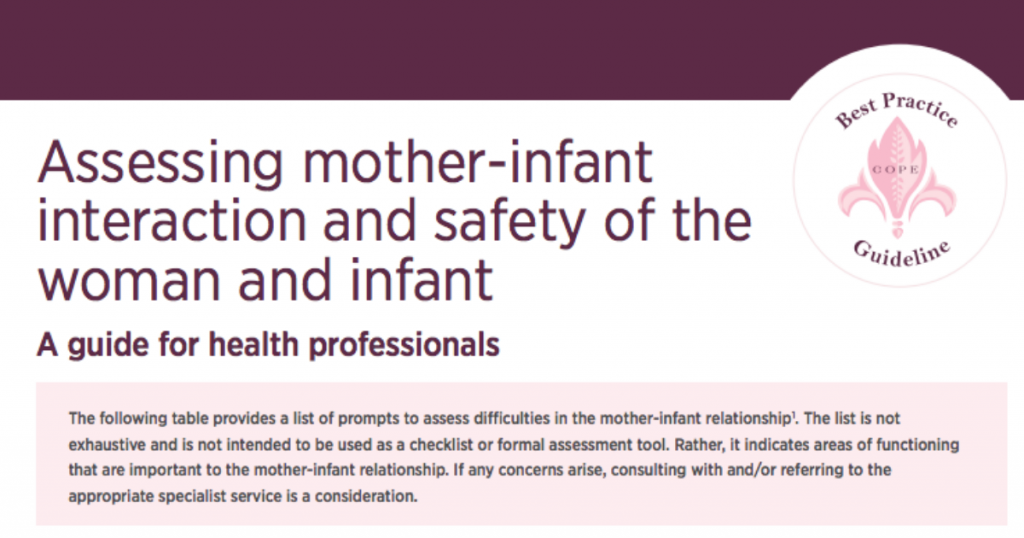Assessing mother-infant interaction
Assessing mother-infant interaction should be an integral part of the care of women in the postnatal period. Maternal factors contributing to difficulties with mother-infant attachment include:
- A history of abuse or neglect
- Adoption or multiple placements or carers
- Severe difficulties in interpersonal relationships
- Past or current domestic violence
- Complex obstetric history
- Severe intellectual disability
Infant factors affecting attachment include medical complications, prolonged separations from the mother, prematurity, developmental disorders and infant temperament. It is important to see the mother and infant together, observe their interaction closely and watch for patterns of interaction — especially whether the infant is able to ‘use’ the mother as a secure base from which to explore, as well as how the mother responds when attachment behaviour is triggered by the infant (see the below table). If any of these indicators are present, consider referral, based on your clinical judgment, to a specialist with perinatal mental health training (e.g. enhanced child and family health nurse, psychologist, psychiatrist, mental health nurse).
Below is a list of prompts to assess difficulties in the mother-infant relationship. The list adapted from Stefan et al (2009) is not exhaustive and is not intended to be used as a checklist or formal assessment tool. Rather, it indicates areas of functioning that are important to the mother‑infant relationship. If any concerns arise, consulting with and/or referring to the appropriate specialist service is a consideration.
Psychosocial risk factors
- Unresolved family of origin issues
- History of physical/sexual abuse, family violence, childhood neglect
- Past pregnancy loss or excess pregnancy concern
- Unplanned or unwanted pregnancy
- Was the mother able to touch the baby on the day of birth?
- Did the mother have responsibility for infant care during the first week of life?
- Who is involved in the baby’s care?
- Availability of emotional/social/practical support
- How much time does the mother spend away from the baby?
- Is the mother excessively worried about the baby?
Infant factors
- Is baby achieving normal developmental milestones?
- Is the baby growing adequately?
- Are there feeding difficulties, reflux, gastric distress, sleep difficulties?
Infant behaviour of concern (observed or reported)
- Gaze avoidance
- Flat affect
- Lack of crying
- Limited vocalising
- Emotionally under-responsive
- Interacts too easily with strangers (age-dependent)
- Unsettled sleep or feeding
- Difficult to console when distressed
- Irritable, constant crying
- Difficulty separating from parent (age-dependent)
Relationship factors (observed or reported)
- Is the mother thoughtful about her baby?
- Can the mother describe the baby’s daily routine?
- Is the mother able to reflect on the baby’s needs?
- Does the mother express empathy for the baby?
- Does the mother engage in enjoyable activities with the baby?
- Does the mother play/talk appropriately with the baby?
- Does she delight in her baby?
- Does the baby ever make her feel uncomfortable, unhappy or enraged?
- Is the mother excessively worried about the baby?
- Does the mother cope with the baby’s distress?
- Does she respond and attend appropriately to the baby’s cues?
- Are her responses consistent?
- Is she protective of the baby?
Maternal factors
- Current maternal psychopathy
- Antenatal or postnatal mood disorder
- Psychosis
- Diagnosed personality disorder
- Suicidal or homicidal ideation
- Negative symptoms (low motivation, anhedonia, blunted affect, poverty of thought/speech)
- Medication side-effects
- Substance abuse
- Engaging in dangerous or risk-taking behaviours (e.g. alcohol or drug misuse)
Protective factors
- Mother is sensitive to the baby
- Mother is able to monitor the baby’s well-being adequately
- Mother is responsive to the baby
- Mother is able to cope with flexibility in her routine
- Mother has a close relationship with at least one other adult
- Mother is thoughtful about what might be going on in the baby’s mind.
Adapted from: Stefan J, Hauck Y, Faulkner D et al (2009) Healthy Mother-infant Relationship: Assessment of Risk in Mothers with Serious Mental Illness. North Metropolitan Area Health Service, Mental Health, WA Department of Health.
Risk to the infant
If difficulties with the mother-infant interaction as outlined above are observed and/or if the woman has a significant mental health condition, further assessment will be required. Risk of harm to the infant can be related to suicide risk in the mother but can also be a separate issue. Although expressions of fear of harming the baby may be a sign of anxiety rather than intent, these should always be further assessed.
The way in which risk to the foetus or infant is assessed depends on the setting and the extent of the therapeutic relationship. The following are examples of questions that could be asked, taken from the Postpartum Bonding Questionnaire (Brockington et al 2006) and adapted to the perinatal context:
- Have you felt irritated by being pregnant or by your baby?
- Have you had significant regrets about becoming pregnant or having the baby?
- Does the baby feel like it’s not yours at times?
- Have you wanted to harm your unborn child or shake or slap your baby?
- Have you ever harmed your baby?
Action will depend on the answers to these questions. It is preferable that the mother and infant remain together but, if there is a perceived risk of harm to the infant, involvement of others (e.g. father or co-parent) in caring for the infant or alternative arrangements are advisable.
Notification to the relevant child protection agency may be necessary. All health professionals should be familiar with the legislation concerning reporting of concerns about children at risk of harm from abuse or neglect in their State or Territory. Health services and child and maternal agencies will generally have internal policies setting out these requirements.
Australian National Suicide Prevention Strategy (NSPS) website— www.livingisforeveryone.com.au
Download a Summary of Mother-Infant Assessment
Save a copy of this information to your computer with our fact sheet.
